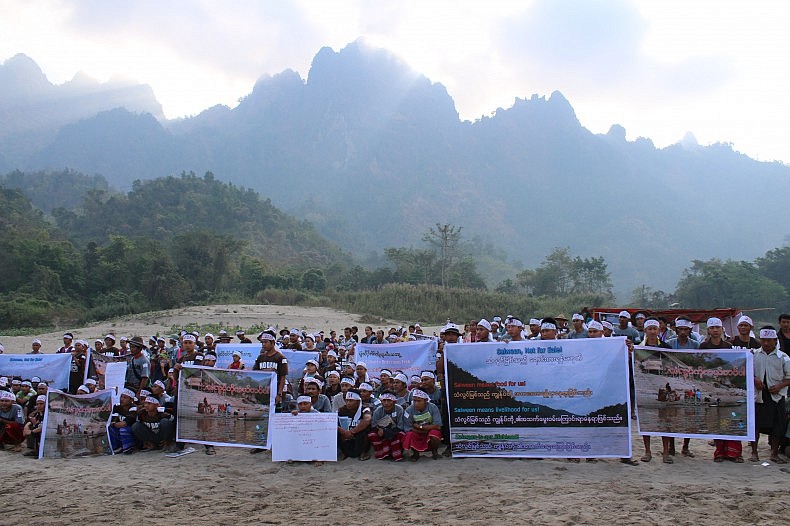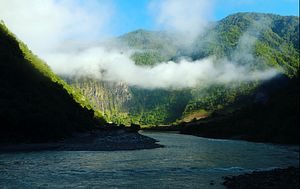Hpa-an, Karen State Myanmar — From the snow-capped mountains of Tibet, the Salween rushes through spectacular gorges in Yunnan Province, then flows through four of Myanmar’s ethnic states before emptying into the Andaman Sea. This is the last great undammed river of East Asia.
Hydropower dams are proliferating across the globe with mega-dams being built in the Amazon, the Congo and along the Mekong. With 3,700 hydropower dams under construction worldwide, it is hard to find any important major river left that has escaped unscathed, and undammed. But so far the Salween’s pristine nature has surprisingly remained intact
Against the momentum of this global rush to build new dams, can the Salween River hang on to its cherished dam-free status and even become an ecotourism success story?
Ethnic leader Paul Sein Twa, the director of Kesan (Karen Environmental and Social Action Network), is convinced that his people, Myanmar’ Karen ethnic group, can both stop the dams and promote wildlife conservation in the Salween basin at the same time.
He told The Diplomat, “The Salween flows through four ethnic states in Myanmar. Our Karen people as well as other ethnic groups actively protect our river and indigenous people’s rights to use and manage the Salween River democratically. We try to protect this river from being degraded, and dammed,”
The Salween has already had a close call. All 13 dam projects on the river Nu (the Chinese name for the Salween) were suspended by then-Chinese Premier Wen Jiabao in 2004, after two geologists had warned of the high risk that mega-dams could trigger a very strong earthquakes. The suspension also followed a campaign led by Kunming-based NGO Green Watershed.
In Yunnan, a provincial chief recently announced a plan to go beyond suspension with the idea to set up a new national park along the undammed river.
Downstream in Myanmar, 300 local Karen leaders, including representatives from three townships, decided to create a “Salween Peace Park” from a protected wildlife sanctuary where endangered species including leopards and tigers still roam. This remote area is protected by the KNU Karen National Union and their armed wing, the KNLA (the Karen National Liberation Army).
The Peace Parks Foundation envisages the establishment of a network of protected areas that links ecosystems across international borders.
The ethnic peoples living along the Salween are determined to resist all attempts to go ahead with the six dams approved by the- previous Thein Sein government in 2013.
These agreements, made with Chinese hydropower companies and Egat (Thailand’s Electricity Commission) without any parliamentary debate or public consultation, lack credibility, and could well be challenged by the new government.

Karen people demonstrating on the banks of the Salween River for the International Day of Action for Rivers and Against Dams on March 14. Image courtesy of Kesan.
Millions of voters from the ethnic states that helped to elect the new National League for Democracy (NLD) government are hoping that these dams will be cancelled on their stretch of the Salween.
Currently, the only guide to the energy policy of the new Aung San Suu Kyi–led government is their election manifesto, which pledged a critical review of hydropower projects and a more eco-friendly policy.
In the ethnic Shan State, rolling protests have been directed against a mega-dam project, the Mongton Dam. If built, it would become one of the biggest dams in Asia, with flood waters inundating vast swathes of Shan State, engulfing villages temples and much agricultural land with a projected reservoir area over 600 square kilometers.
The latest reports in the Thai media indicate that the Chinese and Thai investors have been pressured to redesign the goliath Mongton Dam into two smaller dams.
An Australian company, SMEC (the Snowy Mountain Engineering Corporation), appointed by the Chinese dam company to conduct the environmental and social impact assessments was greeted with a series of anti-dam protest by ethnic Shan communities in 2015. NGOs slammed the role of the company. “It is becoming apparent that SMEC’s (impact assessment) process is simply a sham, aimed to rubber-stamp the Mongton dam plans, rather than objectively assess the project’s actual impacts,” 16 Shan community-based groups said in a statement.
The Karen resistance to dams downstream from Mongton, including the Hatgyi Dam, is linked to an alternative vision for environmental conservation.
The area that has just been designated the Salween Peace Park is located in a thick forest along the border between Myanmar and Thailand. It is the refuge of some of Asia’s last indigenous peoples and endangered species, including tigers and the clouded leopard.
As Paul Sein Twa of Kesan explained, “The peace park is created to open up a democratic space for all parties to talk about the kind of peace people in Mutraw want. It is a roadmap to durable peace and steps towards a devolved federal union. Peace first, not big business development or big infrastructure projects first.”
Can the Karen achieve a fusion of peace, ethnic rights and wildlife protection?
Karen State is also the home to one of the longest running civil wars in the world, now the subject of a fragile ceasefire.
Since 1962, Myanmar’s military regimes have attempted to crush all ethnic demands for autonomy and human rights, fueling decades of civil war.
In a bid to woo Western governments and investors, peace talks were launched by ex-President Thein Sein, a retired military general. However the meandering peace process, which started in 2012, never got far beyond fragile ceasefire agreements.
Ceasefires with Shan and Karen armed forces have been undermined by Burmese army offensives, sometimes linked to the deployment of troops to secure dam-sites.
The KNLA (the Karen rebel army) have confirmed their readiness to stop any attempt at dam construction by China’s Sinohydro and their partner from Thailand, the Egat Thai Electricity Commission.
Zipporah Sein, vice president of the Karen National Union, told The Diplomat: “If they use force to build a dam in our territory, it will create conflict and it will surely disrupt the current peace building process. KNU has a policy that until we reach the political settlement, mega projects like the Hatgyi dam, and all other mega projects will not be permitted.”
The Karen anti-dam movement, backed by the fifth brigade of the KNLA, is trying to convert the conflict over dams into a bold formula for peace and environmental cooperation with the NLD government.
Much may depend on whether the new government will respect the capacity of the Karen people to administer a “Peace Park” protecting rare and endangered wildlife species as part of Karen campaign for autonomy within a federal system.
“If our way of life and environmental knowledge is recognized and supported, we can continue to protect biodiversity here. We are very organized,” said Saw Blaw Htoo, a biodiversity specialist with Kesan who proudly showed his photos of endangered wild cattle and leopards taken by his camera traps in the designated “Peace Park” wildlife sanctuary.
While many in the predominantly Burmese NLD may question the qualifications and expertise of an ethnic group in running an unofficial wildlife park, some international conservationists are impressed with what the Karen people have already achieved.
Jeff Rutherhood, a Thailand-based environmental consultant, commented, “Many national parks run by governments in the region fail to protect wildlife, because locals don’t have a role in protecting wildlife. In Mutraw District of Karen State, a system of community-supported protected areas with patrols by rangers against poaching is already in place.”
Given the proliferation of poachers and illegal wild-life trafficking all over the region, including Myanmar, some international NGOs are positive about the Karen project.
Dr. Christy Williams, the World Wildlife Fund (WWF) country manager for Myanmar, told The Diplomat, “We very much welcome the efforts of the Karen Forest Department under KNU to protect the wildlife in areas under their control. It is certainly a positive sign. Species such as tigers are extremely dependent on protection and we are glad to hear about the organized effort to protect them.”
Saw Blaw Htoo, points out the benefits of having local authorities’ full support for the park., “In Thailand, if a ranger wants to stop poachers, who will help them? Here if our rangers are outnumbered by armed poachers, we can have two dozen Karen soldiers there in time to help. Our Karen soldiers believe that wildlife protection is part of their job.”
Environmentalists hope the Salween Peace Park will become part of the peace process. “It would be a big win for conservation” says WWF’s Dr Mitchell, “if wildlife conservation protection is part of the larger peace agreement between the Government of Myanmar and the Karens.”
No dams in China — so what next for Myanmar?
The shift in Chinese policy on the Nu river has become even more firmly against dams with the appointment of new Yunnan Provincial Secretary Li Jiheng, who wants to set up a national park to stimulate the region’s budding eco-tourism industry, according to a report in the National Geographic.
“The Nu River will become a world-level tourism destination in 5 to 10 years,” Li said on China National Radio, according to reports by state media. “It will succeed, even surpass the Grand Canyon in the United States.”
A civil society lobby wants the Myanmar government to match the cessation of dams on the upper Salween in Yunnan province. Paul Sein Twa concluded, “If China does not build dams, Burma also should not build any. They should work together. This river should flow freely starting from the river’s source to its mouth”
China has already decided the risks were too high to go ahead with these dams. If Myanmar follows suit, then the dream of trans-boundary Chinese- Myanmar cooperation could become a win-win reality, which would keep the river undammed and at the same time promote eco-tourism and wildlife conservation.
Tom Fawthrop is a freelance journalist and film-maker based in Southeast Asia His film “Mega-dams on the Salween” was recently broadcast on DVB TV station.

































